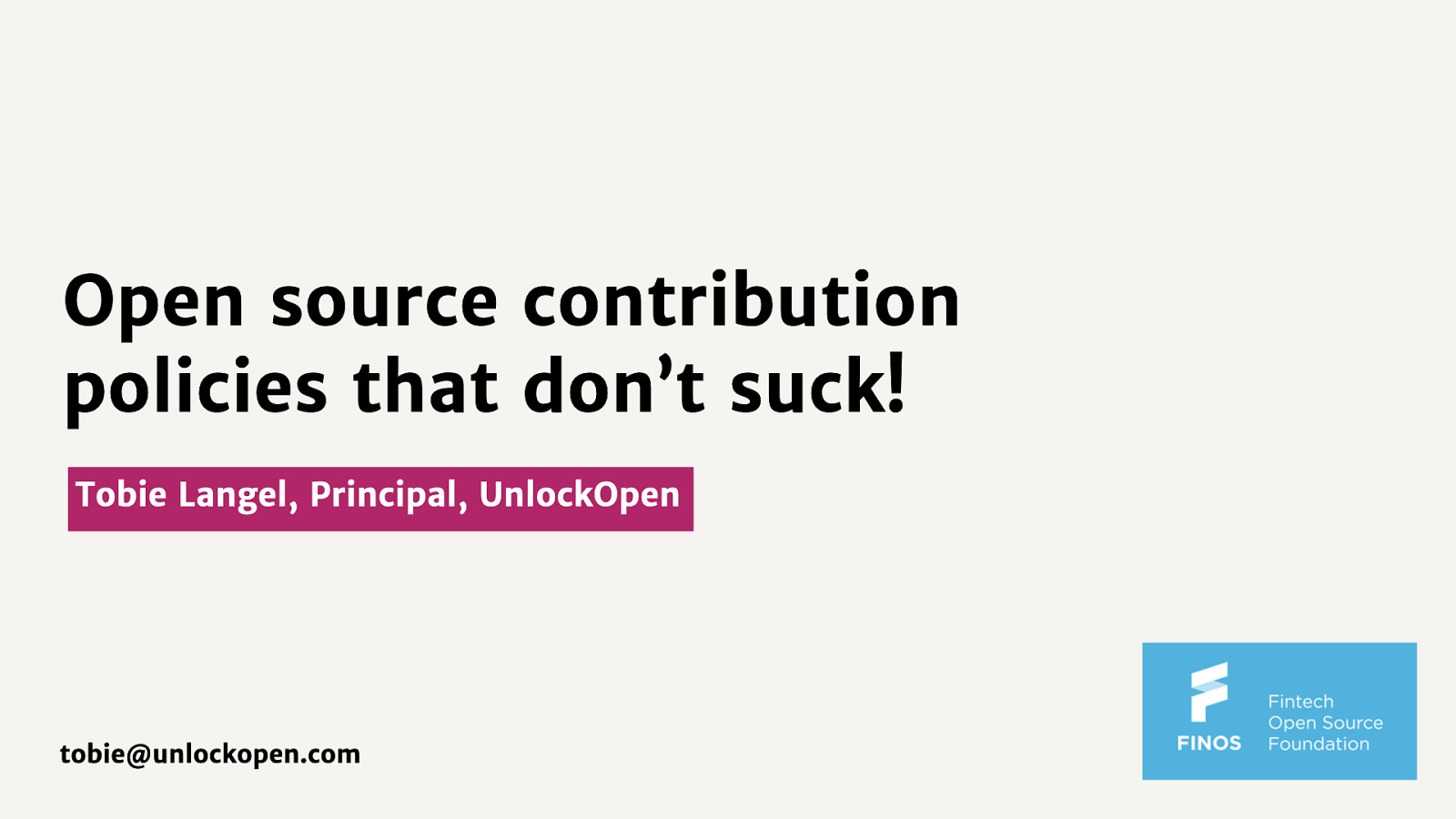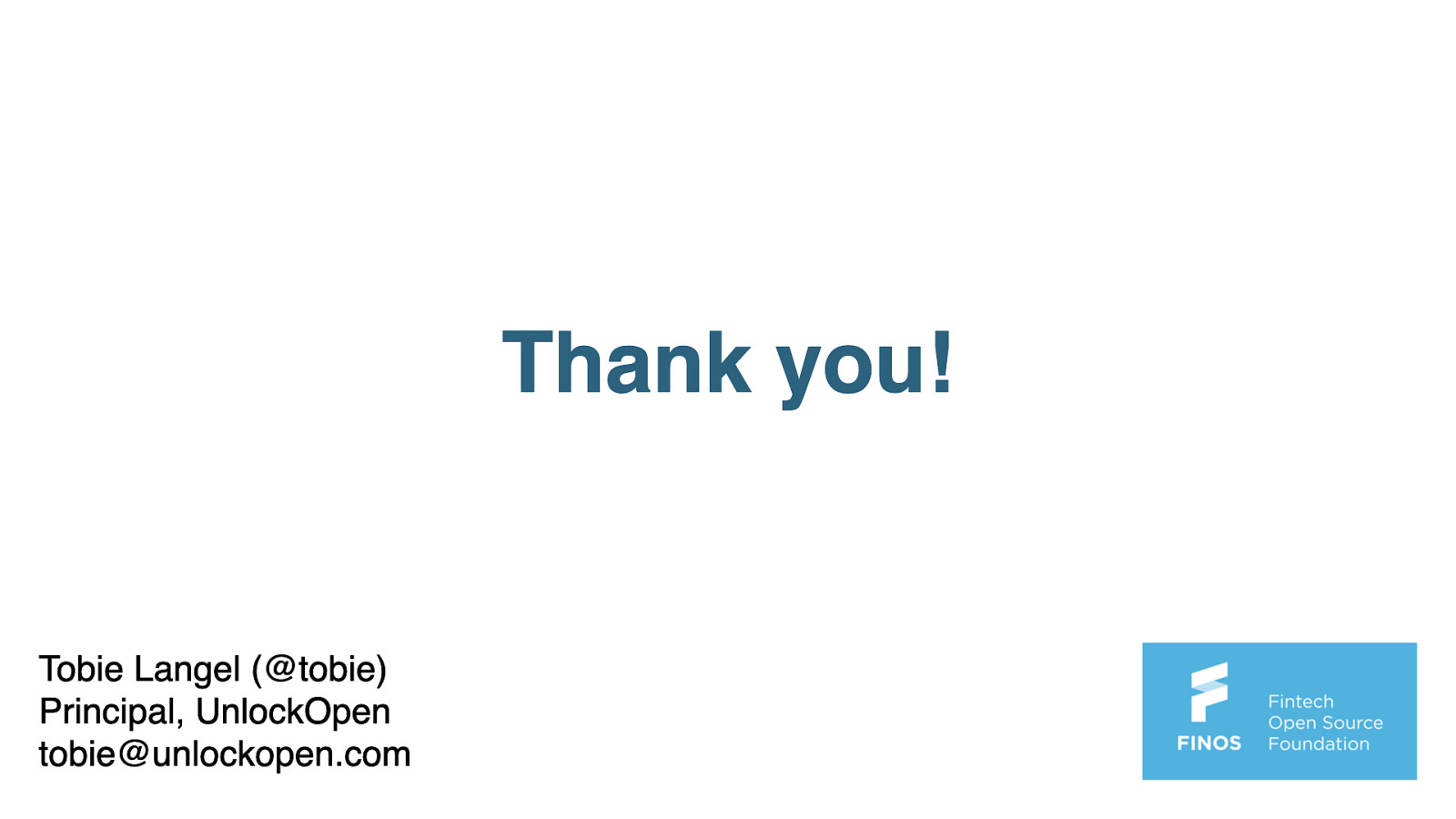Open source contribution policies that don’t suck!
Tobie Langel, Principal, UnlockOpen @tobie tobie@unlockopen.com
A presentation at FINOS Open Source Readiness in March 2020 in by Tobie Langel

Tobie Langel, Principal, UnlockOpen @tobie tobie@unlockopen.com

Do you have an open source policy? < 250 employees 28% No 48% Yes 39% Don’t know 13% 61% 11%
10,000 employees 25% 10% 65% Remember this is a biased sample! Source: The New Stack & Linux Foundation/TODO Group 2018 Open Source Program Management Survey (https://github.com/todogroup/survey)

What does not having a policy mean? Contrary to popular belief, it does not mean that you don’t have an open source policy at all. It means that you don’t have a written one. You have a policy, whether it is written down or not. It could range from “no open source at all” to “anything goes.” —Heather J. Meeker, Open Source Licensing Specialist, author of Open Source for Business.

So what does not having a written open source policy mean? What not having a written open source policy generally means depends on the company size and maturity: • For small companies, this usually implies a very permissive situation: “Do whatever you want!” • For startups, it tends to mean: “Focus on the product, don’t waste time with open source!” • For larger corporations on the other hand, this generally means: “Nope, not a chance.”

Think you’re in the right camp because you have an open source contribution policy? Think again! • You can have a very restrictive open source policy. • You can have a very bureaucratic process to obtain approval. • You can have a very opaque process to obtain approval. None of these are fun!

Explicit Trend setters Old tech company Tech companies Restrictive Permissive Non-tech enterprise SMEs Startups Implicit

Permissive. Allows open source contribution to be an integral part of the company’s engineering culture and best practices. Based on trust and autonomy.
Explicit. The decision making process is well documented and transparent. Informative. The policy explains the why an helps educate engineers.
Frictionless. Avoid bureaucracy, red tape, lengthly back and forth with legal, etc.

Minimizes risk. Avoid: • giving away competitive advantage, • giving away IP that can be used defensively (or—shudders— offensively), • reputational damages and accidental infringements.
Consistently followed across the company. Keep contribution under your radar. Avoid compliance issues. Savvy about written information. Sometimes you want a paper-trail (e.g. compliance), sometimes you don’t. Doesn’t drown critical problems in a sea of menial issues.

Engineering to be happy and productive. Risks minimized and well understood. Good communication between legal and engineering. Alignment with Business goals.

At the heart is a tension Legal wants to minimize risk. Engineering wants to maximize velocity. Prefers oral communication. Prefers written communication. Manager’s schedule. Maker’s schedule. Favors spectrum thinking. Favors binary thinking. Conservative role. Innovative role.

Coming to agreement Acknowledge that this tension is normal. It’s just checks and balances. Listen to both sides. Remind them that their role is to help achieve common business goals. • Legal’s role is to minimize risk, but not at the expense of innovation. • Engineering’s needs can’t be fulfilled at the expense of the company’s survival. Find common ground. A good policy will improve the life of both sides. Align your open source activity with your business goals. If you are a patent troll, then don’t do open source. Accept that your open source policy will change with your business.

What is a policy really about? Using open source Contributing open source

Using open source Well understood problem, essentially: • Using software with licenses that are compatible with your current and future business model. • Compliance. Tip: a common issue is missing licenses. Equip engineering with a process (and issue or pull request templates) to request proper OSI-approved licenses.

Contributing open source

Contributing outside of work Contributing at work

Contributing outside of work “How does your employer’s IP agreement/policy affect your freetime contributions to open source unrelated to your work?” Other 4% Don’t know 37% But again… this is a highly biased sample. “Respondents were sampled randomly from traffic and qualifying activity Yes! 47% to licensed open source repositories on GitHub.com and invited to complete the survey through a dialog box. A smaller sample was recruited from open source communities sourced outside of GitHub, […]” Must ask 12% Source: GitHub 2017 open source survey (http://opensourcesurvey.org/2017/).

Contributing outside of work Why so much confusion? • Depends on the jurisdiction, but not uncommon, especially in the USA, for companies to own employees’ production 24/7. • Sometimes, extra criteria apply. For example, in California, IP developed with company equipment—even outside of work—belongs to the employer. • This prevents employees from contributing to open source, unless they ask for, and are granted permission to do so.

Contributing outside of work The common solution: ask for permission • Most companies have a process for this. • Tends to focus on releasing open source or working on a limited set of pre-approved projects. • Breaks down when there’s a high number of dependencies (such as for Node.js projects).

Contributing outside of work The better solution: BEIPA • Balanced Employee IP Agreement • https://github.com/github/balanced-employee-ip-agreement • Project created by GitHub, based on its own IP agreement. • BEIPA only claims control of creations made for or relating to the company’s business.

Contributing at work

Releasing Patching

Releasing open source at work • Distinguish large open source projects you want to promote from smaller “day to day” modules. (E.g. Google’s < 100 LoC rule.) • Offer well oiled and well documented processes, checklists, templates, and tooling (see: https://github.com/todogroup/policies). • Offer help. • Promote working in the open rather than releasing software once it’s done. (Consider README-driven development to avoid scope creep.)

Patching open source at work • By far the most common activity and the most important one. • The experience must be as frictionless as possible for engineers. • Surface the process by which decisions are made and trust engineers to do the right thing. This let’s legal focus on the difficult cases. • Cache decisions (build approve- and deny- lists) so that the process gets faster as time goes by.

Contributing open source Releasing Using open source Outside of work Patching At work

Turn your policy into an app! • Automatically approve requests that meet pre-established requirements (e.g. patch an MIT-licensed open source project on GitHub). • Automatically reject requests that don’t meet your criteria (but allow motivated appeals). • Manually handle other requests and cache the decision so more gets automated over time.

Turn your policy into an app! Using such a system, Adobe was able to shorten it’s review time from 4.6 days to 4.6 hours. But there’s more. The data collected can help: • • • • understand your open source activity, promote it, connect engineers unknowingly contributing to the same projects, etc.

Thank you! Tobie Langel (@tobie) Principal, UnlockOpen tobie@unlockopen.com